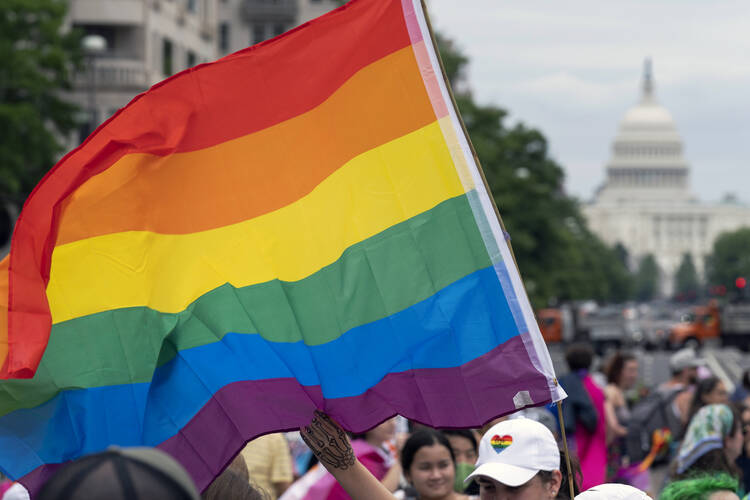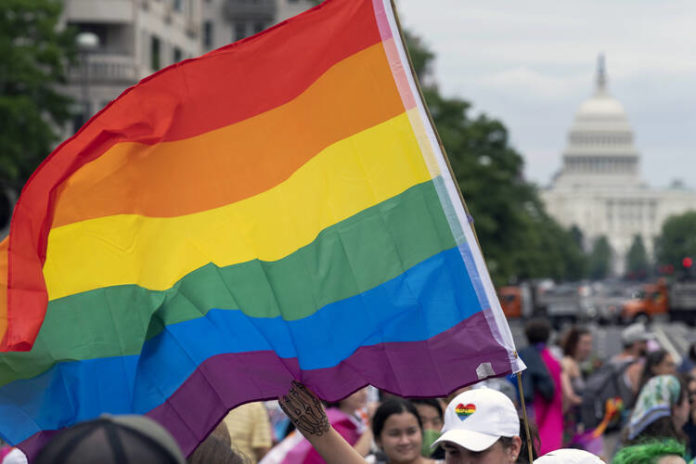
“The Supreme Court’s Next Target Is Marriage Equality.” So reads Slate’s headline for a piece by Mark Joseph Stern, echoing frequent commentary that has not often been challenged since the Supreme Court overturned Roe v. Wade in Dobbs v. Jackson Women’s Health Organization on June 24. In fairness to Mr. Stern and others, the first to make this assertion were the dissenters in Dobbs (Justices Stephen Breyer, Sonia Sotomayor and Elena Kagan). Though the majority opinion in Dobbs promises that rights to same-sex marriage and birth control are not affected, the dissenters protest that “it is impossible to understand (as a matter of logic and principle) how the majority can say that its opinion today does not threaten—does not even ‘undermine’—any number of other constitutional rights.”
In my view, neither the dissent opinion nor the many commentators agreeing with it on this point have a very strong argument. There are significant points of distinction between the majority’s analysis of Roe and any implications for other rights that are not enumerated in the Constitution, as well as what we might call social facts that further shield those rights. Any suggestion that Dobbs threatens those other cases amounts to a claim the majority in Dobbs is lying. That is an assertion, not an argument. But it is worth understanding the fear that same-sex marriage is in jeopardy before explaining why I think that fear is mistaken.
Any suggestion that Dobbs threatens those other cases amounts to a claim the majority in Dobbs is lying. That is an assertion, not an argument.
The strongest arguments for the view that Dobbs threatens previous decisions dealing with same-sex marriage and birth control are (1) that Dobbs undermines their logic, and (2) that Justice Clarence Thomas, one of the five in the Dobbs majority decision, wrote a concurrence expressly calling for those earlier decisions to be revisited. The majority arguably puts it too strongly when it says, “[n]othing in this opinion should be understood to cast doubt on precedents that do not concern abortion.” After all, three members of the current court (Chief Justice John Roberts and Justices Thomas and Samuel Alito) dissented in Obergefell, which legalized same-sex marriage nationwide, and their reasoning was very similar to, if not identical with, their reasoning in Dobbs: In order for a right that is not enumerated by the Constitution to be recognized by judges as a constitutional right, it must be “deeply rooted in this Nation’s history and tradition” and “implicit in the concept of ordered liberty.”
It seems unlikely that any of the five justices in the majority decision in Dobbs, or Chief Justice Roberts (who concurred in the result), believe those conditions apply to protections for birth control or same-sex marriage. So why is it even a question whether those rights are in grave jeopardy after Dobbs? (Some even suggest that Dobbs places interracial marriage in jeopardy, but that right, from Loving v. Virginia, rests primarily on equal protection grounds, making it different from cases about unenumerated rights.) Isn’t the majority just hiding the ball when it suggests that Dobbs is only about abortion and any suggestion to the contrary is a “mischaracterization”? I think not, for several reasons.
Isn’t the majority just hiding the ball when it suggests that Dobbs is only about abortion? I think not, for several reasons.
The majority’s decision has two basic components, each of which is necessary to its decision to overturn Roe. The first is the conviction that Roe was “egregiously wrong” when decided, and the second is the weighing of various factors the court has traditionally invoked under the doctrine of stare decisis (“to stand by things decided”), a practice under which the court generally upholds even questionable decisions in the interest of legal stability—unless special considerations warrant revisiting them. On the first component, we have already seen the basic argument: The court is convinced that Roe established a right (taking away power from the electorate) that was not rooted in our nation’s history or traditions, nor in the concept of ordered liberty. On the second component, the court had many things to say that make it very easy to distinguish the right to contraception established in Griswold v. Connecticut or the right to same-sex marriage granted in Obergefell from the right to abortion created in Roe.
Dobbs recognizes another life at stake
In Dobbs, the court says it is examining the Roe decision and its authors in light of “the nature of their error, the quality of their reasoning, the ‘workability’ of the rules they imposed on the country, their disruptive effect on other areas of the law, and the absence of concrete reliance.” I will focus here on the first and last factors.
First, the court argues that, as even the Roe decision (and Planned Parenthood v. Casey, the 1992 decision that reaffirmed the right to abortion) itself recognized, at stake in these cases is both the right of a woman to control her own body and the rights, if any, of the other life at stake, the unborn child. There is no similar competing rights claim, says the court in Dobbs, in cases involving contraception or same-sex marriage. So the court states that the nature of the error in Roe is fundamentally different from any error in those other cases, and Roe is not reducible to simply recognizing a right that is not rooted in tradition or the concept of ordered liberty. Further, those other cases do not take away from the people the right to decide how to adjudicate any claim of rights on the part of the unborn or any other party. In Dobbs, the court leaves it to California to be California and Mississippi to be Mississippi—that is, it does not suggest that the Constitution settles whether the unborn should have any rights at all.
The court states that the nature of the error in Roe is fundamentally different from any error in those other cases.
In addition to fundamentally distinguishing the nature of any error in these various cases, the court adds, importantly, that “[e]ach precedent is subject to its own stare decisis analysis, and the factors that our doctrine instructs us to consider like reliance and workability are different for these cases than for our abortion jurisprudence.” Justice Alito makes this point just after considering at length the notion of “reliance” on prior decisions—essentially, whether people have made plans to do something, counting on the fact that the court has told them it is legal. The court argues that, as Casey recognized, people cannot be said to “rely” on abortion in the traditional sense of reliance that courts have looked to in stare decisis, since people do not plan to have abortions. (The dissent argued strenuously that people have made life decisions expecting to have recourse to abortion, but whether that should suffice to establish reliance is beyond the scope of this essay.)
It is easy to see how this traditional notion of reliance would work quite differently in the case of birth control (people very much plan on its use and shape their lives accordingly) and same-sex marriage (people have built lives, families and futures together). Even if one rejects the court’s reasoning as to reliance in Dobbs it still seems much easier and more traditional to establish reliance with respect to these other rights. So at least in the two areas where the court spends most of its time, the nature of the error (is there another potential rights claim involved?) and the nature of the reliance interest (are we disrupting concrete plans?), the court’s own opinion gives ample reason to distinguish these cases at the level of logic and principle, despite the dissent’s assertion to the contrary.
The different politics of same-sex marriage
Besides the portions of the court’s own argument that indicate it is not a straightforward leap from overturning Roe to overturning Griswold or Obergefell, there are social conditions that differ in each case. As readers of America know well, so deeply held were the differences the court had attempted to settle for once and all in Roe that the decision gave rise to a 50-year movement of resistance among men and women of various faiths (and of none). Roe also deeply divided the political parties and led to annual marches, prayer protests and even, lamentably, occasional violence. Nothing similar has occurred in the case of birth control or same-sex marriage. Furthermore, recent polls show approval of same-sex marriage above 70 percent, but polling on abortion has always shown a much more complicated picture, with most Americans falling into a murky middle between Roe’s regime and, say, Catholic social teaching.
So even a cynical legal realist who believes judges are doing more politics than law would have to acknowledge a bright distinction between the politics of abortion and those of birth control or same-sex marriage. To be sure, there are some anomalous cases (narrow questions about whether certain forms of birth control may also act as abortifacients, for example), but these don’t make the distinction hard to see. They stand out because the distinction is easy to see.
Recent polls show approval of same-sex marriage above 70 percent, but polling on abortion has always shown a much more complicated picture.
Finally, we might note that in addition to Justice Thomas’s solo concurrence calling for the revisiting of those other cases, Justice Kavanaugh wrote separately to emphasize just those social facts that I raised above, as well as his own commitment to the argument that the opinion of the court does not cast doubt on those other precedents. Further, Justice Gorsuch famously authored the opinion in the landmark Bostock case that said employment discrimination against gays and lesbians is discrimination on the basis of sex and thus violates the Civil Rights Act of 1964. It seems very unlikely that either justice is eager to revisit Obergefell, let alone Griswold. Recall that even Justice Alito, in his confirmation hearings, agreed with the extension of the right to contraception established in Griswold’s to unmarried couples: “I do agree with the result in Eisenstadt,” he testified, saying he felt free to do so because no case is ever likely to reach the court asking it to rule otherwise.
Where does this leave us? Well, the court could always be lying, but, again, that is not really an argument—it is an assertion. And Catholics should be wary of an assertion that echoes frequent and infamous attacks on Catholic justices as dogmatists with a Roman agenda rather than a commitment to law. Nobody can predict the future with certainty, but we can look at the Dobbs opinions and context and say that while some of their arguments (arguably) and Justice Thomas’s concurrence (inarguably) cast doubt on the soundness of the rulings in Griswold and Obergefell at first blush, there are multiple reasons to think that ordinary stare decisis makes the cases very distinguishable in principle, logic and politics.
[Read next: “Archbishop Wester: The Catholic Church should baptize children of same-sex couples”]







